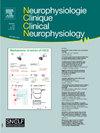Stereoelectroencephalography at Sainte-Anne Hospital, Paris, France
IF 2.4
4区 医学
Q2 CLINICAL NEUROLOGY
Neurophysiologie Clinique/Clinical Neurophysiology
Pub Date : 2025-02-05
DOI:10.1016/j.neucli.2025.103057
引用次数: 0
Abstract
Stereoelectroencephalography (SEEG), which combines the exploration of identified intracerebral structures using depth electrodes and provides direct recording of local field potentials from multiple brain sites, was designed and developed in the 1950s by Jean Talairach and Jean Bancaud, in Sainte-Anne Hospital, Paris.
For patients with focal drug-resistant epilepsy, when the non-invasive phase is insufficiently concordant or when relationships between the epileptogenic network and eloquent areas remain to be defined, the main purpose of SEEG is the optimal electrode implantation based on a main hypothesis and questions formulated during the non-invasive phase.
Following an initial historical overview, the different steps of this non-invasive phase are described. Some of these steps, like semiology analysis, have remained relatively preserved, while others have considerably evolved, such as positron emission tomography combined with 3 Tesla magnetic resonance imaging (MRI), functional MRI (fMRI) and high-resolution EEG.
We then outline the different steps of the SEEG procedure as performed in our institution. Here also, some steps remain quite unchanged such as intracerebral stimulation, amitriptyline and benzodiazepine tests while some others have strikingly evolved such as frameless robot-assisted, MRI-based implantation, depth-signal analyses and quantifications, and radio-frequency thermocoagulation.
法国巴黎圣安妮医院的立体脑电图
立体脑电图(SEEG)是20世纪50年代由巴黎圣安妮医院的Jean Talairach和Jean Bancaud设计和开发的,它结合了使用深度电极对已识别的脑内结构的探索,并提供了来自多个脑部位的局部场电位的直接记录。对于局灶性耐药癫痫患者,当非侵入性阶段不充分协调或当致痫网络与言语区域之间的关系仍未明确时,SEEG的主要目的是基于非侵入性阶段制定的主要假设和问题进行最佳电极植入。在最初的历史概述之后,描述了这个非侵入性阶段的不同步骤。其中一些步骤,如符号学分析,相对保留了下来,而其他步骤则有了相当大的发展,如正电子发射断层扫描结合3特斯拉磁共振成像(MRI),功能磁共振成像(fMRI)和高分辨率脑电图。然后,我们概述了在我们机构中执行的SEEG程序的不同步骤。在这方面,一些步骤仍然保持不变,如脑内刺激,阿米替林和苯二氮卓类药物测试,而其他一些步骤则有了惊人的发展,如无框架机器人辅助,基于核磁共振的植入,深度信号分析和量化,以及射频热凝。
本文章由计算机程序翻译,如有差异,请以英文原文为准。
求助全文
约1分钟内获得全文
求助全文
来源期刊
CiteScore
5.20
自引率
3.30%
发文量
55
审稿时长
60 days
期刊介绍:
Neurophysiologie Clinique / Clinical Neurophysiology (NCCN) is the official organ of the French Society of Clinical Neurophysiology (SNCLF). This journal is published 6 times a year, and is aimed at an international readership, with articles written in English. These can take the form of original research papers, comprehensive review articles, viewpoints, short communications, technical notes, editorials or letters to the Editor. The theme is the neurophysiological investigation of central or peripheral nervous system or muscle in healthy humans or patients. The journal focuses on key areas of clinical neurophysiology: electro- or magneto-encephalography, evoked potentials of all modalities, electroneuromyography, sleep, pain, posture, balance, motor control, autonomic nervous system, cognition, invasive and non-invasive neuromodulation, signal processing, bio-engineering, functional imaging.

 求助内容:
求助内容: 应助结果提醒方式:
应助结果提醒方式:


